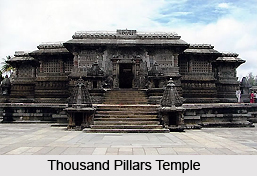 The historic Thousand Pillars Temple in the Hanamakonda town is the great legacy of the Kakatiya kings. Built during the 12th century under the patronage of Kakatiya king, Rudra Deva, the temple is almost 855 years old. The temple deity is Rudreshwara Swamy, a personification of Lord Shiva since the Kakatiya kings had a special devotion for Shiva. The temple deity was actually named after King Rudra Deva in line with the traditions of that time, hence the name Sri Rudraeshwara Swamy Temple.
The historic Thousand Pillars Temple in the Hanamakonda town is the great legacy of the Kakatiya kings. Built during the 12th century under the patronage of Kakatiya king, Rudra Deva, the temple is almost 855 years old. The temple deity is Rudreshwara Swamy, a personification of Lord Shiva since the Kakatiya kings had a special devotion for Shiva. The temple deity was actually named after King Rudra Deva in line with the traditions of that time, hence the name Sri Rudraeshwara Swamy Temple.
The Temple is one of the finest specimens of Kakatiya architecture and sculpture. The entrance gateways, ceilings and pillars of the structure are all embellished with elaborate and exquisite carvings that depict human activities, showing fresh charms, elegance and an almost metallic finish. The supreme workmanship accomplished by the sculptor of that age can be fathomed by the perforated screen pattern on the flanks of the door jambs, female figures in various dancing poses. Among the ancient temples of Telangana the Thousand Pillars Temple has an unique star shape which is an architectural marvel in itself and has now become a popular tourist attraction. One of the sculpted structures is a monolith carved out of a single stone of black basalt. It is the figure of Nandi, the bull, who presents a glimpse into the artistic finesse of the bygone eras.
The temple stands on a platform of 1 metre, which slopes towards the Hanamakonda hill. Inside the majestic temple, there are three shrines. One of the interesting aspect of the Thousand Pillars Temple is that here the third deity is not Lord Brahma, who is considered to be one of the Trinity (Lord Shiva, Vishnu, Brahma). Here, Lord Surya is worshipped as the thid deity. In addition to the three presiding deities, the temple precincts are also strewn with several lingam shrines. The garden surrounding the temple is well maintained thus making the entire setting more aesthetically pleasing.
The temple got desecrated by the Tughlaq dynasty during their invasion of the Deccan. It is currently managed by the Archaeological Survey of India and was renovated by the Government of India in 2004.
Visiting Information on Thousand Pillars Temple
The Warangal railway station is at a distance of 6 km from the temple. The nearest airport to the temple is the Rajiv Gandhi International Airport at Hyderabad.





















